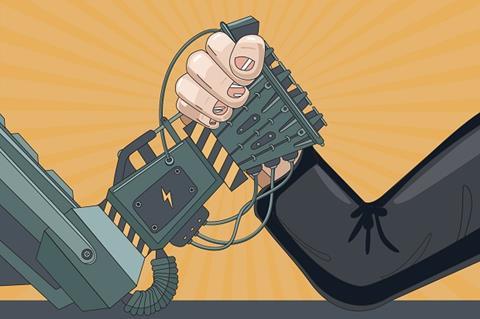The number of manual processes found within a typical financial services company has resulted in this sector emerging as one of the leaders in the use of automation technologies, says Adam Rates, head of IT strategy and architecture at Allianz
Robotics Process Automation (RPA) is already being exploited by banks and financial institutions for back office process optimisation, data analysis and to improve customer experience.

Tasks can be performed faster, more cheaply and to high degrees of accuracy. RPA eliminates the scope for human error; robots don’t become distracted, weary or ill and they can work 24/7 without the need for breaks.
Impact on workforce
Understandably some employees have voiced concern regarding the outlook for their own jobs. Earlier this year a large insurance company received press coverage for allegedly asking its workforce if they could be replaced by robots, undoubtedly compounding fears that automation equals redundancy. However many experts reassure that automation will have a positive influence for our workforce, through releasing employees from tedious, uninspiring tasks to work on more value-add, skilled activities. The message coming through is that this advancement is about supporting and enabling human employees rather than swapping man for machine.
Choosing the right processes
RPA is not suitable for all processes, and sometimes only part of a process can be automated. Candidate processes must be clearly defined without the requirement for cognitive decisions; however this does not mean the robot cannot carry out logical rules such as mathematics, comparisons and pattern matching. RPA’s limitation is that it does not understand the activity it carries out and is simply following a predefined list of steps. The selection of appropriate processes to automate is key, alongside effective change management and communications.
RPA and beyond
The next step in the automation journey is IPA (Intelligent Process Automation). Whereas RPA merely follows instructions, IPA (combining RPA and Artificial Intelligence is capable of learning from experience and applying this to improve on future tasks. Increasingly, AI is fast becoming part of our daily life. Examples include mobile phone ‘personal assistants’ Siri and Cortana; Amazon’s ‘Alexa’ voice service, and several types of fraud detection software used by banks.
For insurers, AI could offer endless opportunities, from spotting patterns and suspicious activity linked to fraud to using virtual assistants and chatbots. Some insurers are exploring the use of AI for risk assessment and selection and damage categorisation. For an industry typically viewed as staid and old-fashioned, this may present an opportunity for insurance companies to rebrand themselves as leaders in digital innovation.
Robots and brokers
Whilst the role of the broker will likely adapt in line with these advances in technology, the prediction is that larger SMEs and corporates will continue to rely on human brokers for advice and recommendations due to the complexity of the potential risks involved.
Importantly, since the broker role also focusses on flexibility and communication, many customers still prefer human methods over self-service online offerings. However, brokers may want to consider how RPA and AI can be used to enhance their value proposition and apply Big Data to gain deeper insight into consumer needs and behaviour. AI, especially when augmented with Big Data, could be the tool to equip brokers with more information and knowledge to better serve their customers.
Hosted by comedian and actor Tom Allen, 34 Gold, 23 Silver and 22 Bronze awards were handed out across an amazing 34 categories recognising brilliance and innovation right across the breadth of UK general insurance.













































No comments yet